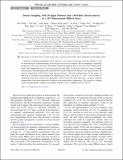Files in this item
Boson sampling with 20 input photons in 60-mode interferometer at 1014-dimensional Hilbert space
Item metadata
| dc.contributor.author | Wang, Hui | |
| dc.contributor.author | Qin, Jian | |
| dc.contributor.author | Ding, Xing | |
| dc.contributor.author | Chen, Ming-Cheng | |
| dc.contributor.author | Chen, Si | |
| dc.contributor.author | You, Xiang | |
| dc.contributor.author | He, Yu-Ming | |
| dc.contributor.author | Jiang, Xiao | |
| dc.contributor.author | You, L. | |
| dc.contributor.author | Wang, Z. | |
| dc.contributor.author | Schneider, C. | |
| dc.contributor.author | Renema, J. J. | |
| dc.contributor.author | Hoefling, Sven | |
| dc.contributor.author | Lu, Chao-Yang | |
| dc.contributor.author | Pan, Jian-Wei | |
| dc.date.accessioned | 2020-01-27T10:30:03Z | |
| dc.date.available | 2020-01-27T10:30:03Z | |
| dc.date.issued | 2019-12-20 | |
| dc.identifier | 265378156 | |
| dc.identifier | b3dfea49-ebb8-422a-91d6-225bda14f269 | |
| dc.identifier | 85077268652 | |
| dc.identifier | 000503245200002 | |
| dc.identifier.citation | Wang , H , Qin , J , Ding , X , Chen , M-C , Chen , S , You , X , He , Y-M , Jiang , X , You , L , Wang , Z , Schneider , C , Renema , J J , Hoefling , S , Lu , C-Y & Pan , J-W 2019 , ' Boson sampling with 20 input photons in 60-mode interferometer at 10 14 -dimensional Hilbert space ' , Physical Review Letters , vol. 123 , no. 15 , 250503 . https://doi.org/10.1103/PhysRevLett.123.250503 | en |
| dc.identifier.issn | 0031-9007 | |
| dc.identifier.other | ArXiv: http://arxiv.org/abs/1910.09930v1 | |
| dc.identifier.uri | https://hdl.handle.net/10023/19358 | |
| dc.description.abstract | Quantum computing experiments are moving into a new realm of increasing size and complexity, with the short-term goal of demonstrating an advantage over classical computers. Boson sampling is a promising platform for such a goal; however, the number of detected single photons is up to five so far, limiting these small-scale implementations to a proof-of-principle stage. Here, we develop solid-state sources of highly efficient, pure, and indistinguishable single photons and 3D integration of ultralow-loss optical circuits. We perform experiments with 20 pure single photons fed into a 60-mode interferometer. In the output, we detect up to 14 photons and sample over Hilbert spaces with a size up to 3.7×1014, over 10 orders of magnitude larger than all previous experiments, which for the first time enters into a genuine sampling regime where it becomes impossible to exhaust all possible output combinations. The results are validated against distinguishable samplers and uniform samplers with a confidence level of 99.9%. | |
| dc.format.extent | 7 | |
| dc.format.extent | 1126876 | |
| dc.language.iso | eng | |
| dc.relation.ispartof | Physical Review Letters | en |
| dc.subject | QC Physics | en |
| dc.subject | TK Electrical engineering. Electronics Nuclear engineering | en |
| dc.subject | NDAS | en |
| dc.subject.lcc | QC | en |
| dc.subject.lcc | TK | en |
| dc.title | Boson sampling with 20 input photons in 60-mode interferometer at 1014-dimensional Hilbert space | en |
| dc.type | Journal article | en |
| dc.contributor.institution | University of St Andrews. School of Physics and Astronomy | en |
| dc.contributor.institution | University of St Andrews. Condensed Matter Physics | en |
| dc.identifier.doi | https://doi.org/10.1103/PhysRevLett.123.250503 | |
| dc.description.status | Peer reviewed | en |
This item appears in the following Collection(s)
Items in the St Andrews Research Repository are protected by copyright, with all rights reserved, unless otherwise indicated.

